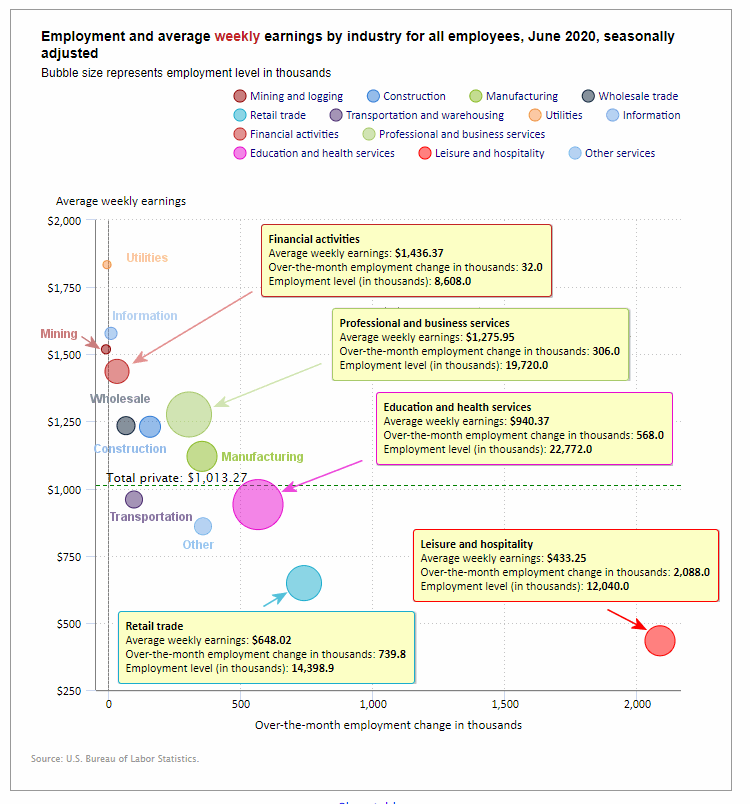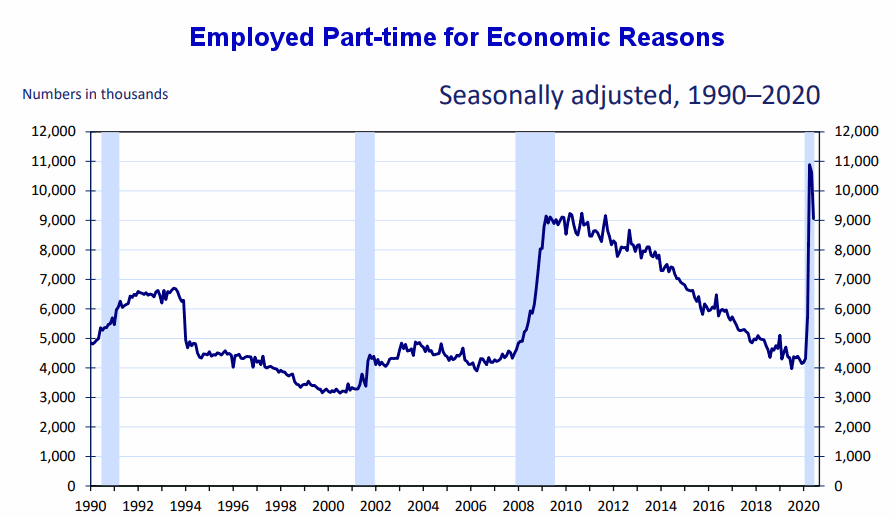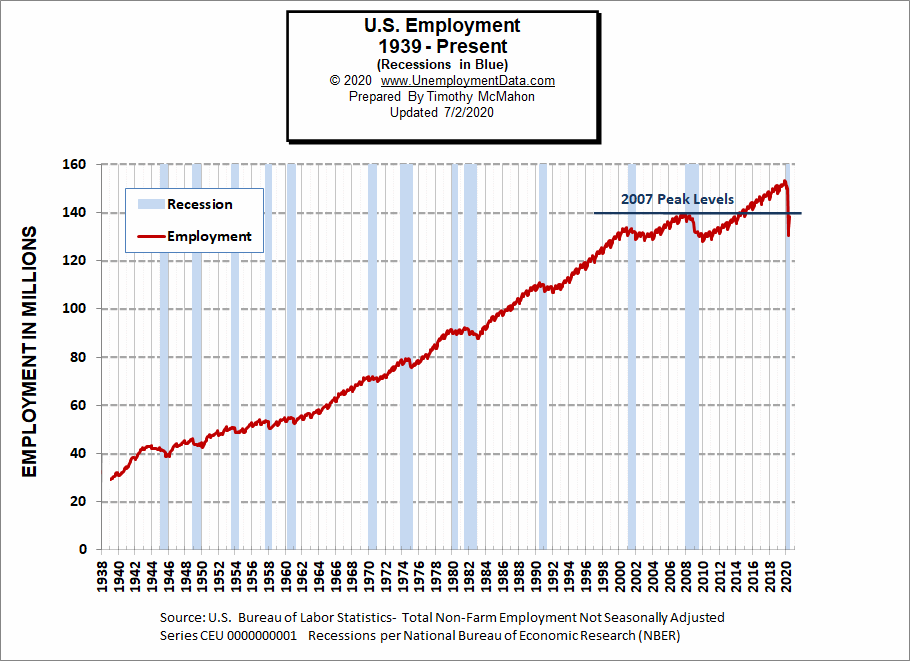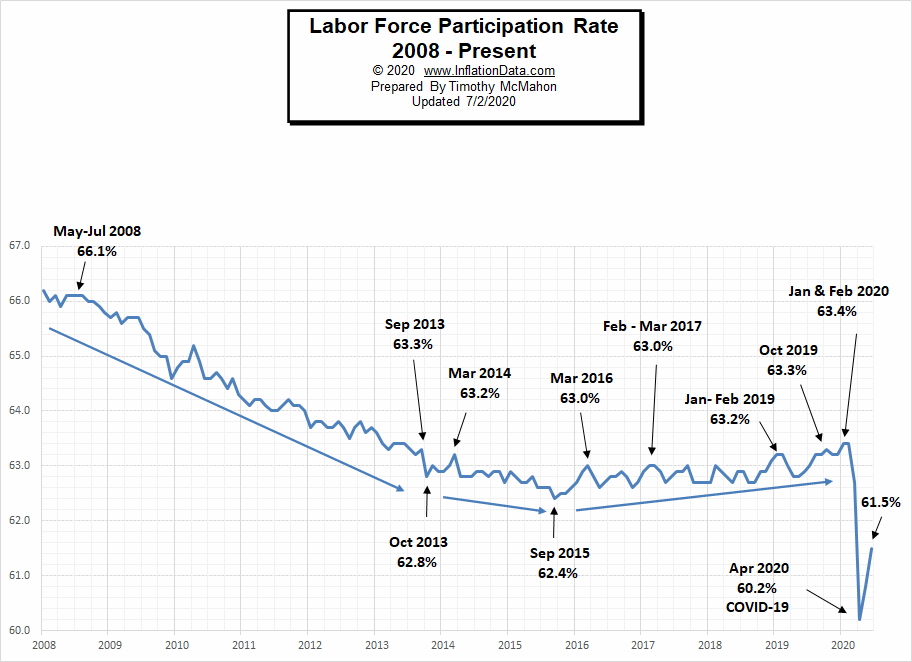![]()
The U.S. Bureau of Labor Statistics (BLS) released its employment / unemployment report for June on July 2nd.
More than 5 million People Return to Work in June as COVID restrictions relax.
- Unadjusted U-3 was Down from 13.0% to 11.2%!
- Adjusted U-3 was Down from 13.3% to 11.1%!
- Unadjusted U-6 was Down from 20.7% to 18.3%!
- Labor Force Participation rose from 60.8% to 61.5%.
- Unadjusted Employment up by approx. 5.1 million jobs.
According to the Commissioner of the U.S. Bureau of Labor Statistics:
“Nonfarm payroll employment increased by 4.8 million in June, and the unemployment rate declined by 2.2 percentage points to 11.1 percent. These improvements reflect the continued resumption of economic activity that had been curtailed in March and April due to the coronavirus (COVID-19) pandemic and efforts to contain it.
In June, employment continued to rise in several major industry sectors, with the largest gain in leisure and hospitality. Notable gains also occurred in retail trade, education and health services, other services, manufacturing, and professional and business services.”
Of course, he is talking about “Seasonally Adjusted Jobs” from the “Current Population Survey (CPS)”
rather than looking at the results reported by actual companies in their “Current Employment Statistics survey (CES)”
But looking at the CES report we see…
Originally the BLS reported 133.342 million jobs for May and then in June, they added 68,000 jobs to that estimate.
So currently they are saying 133.410 million jobs for May and 138.513 million jobs for June which is actually an increase of 5.171 million jobs compared to what they originally reported last month or 5.103 million increase based on their updated estimates.
Unemployment by Education
Those unemployed with less than a High School Diploma fell from 21.2% in April to 19.9% in May to 16.6% in June. At the other end of the spectrum those with a Bachelor’s degree or higher fell from 8.4% in April to 6.9% in June.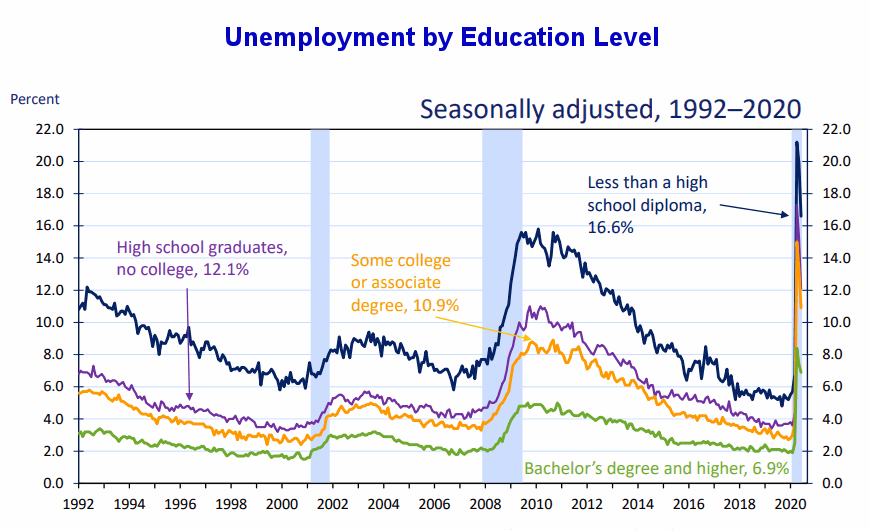
Typically those with a Bachelor’s degree are relatively immune to unemployment. Although during the 2008 recession college grads unemployment rose to slightly above 4%.
Current Employment
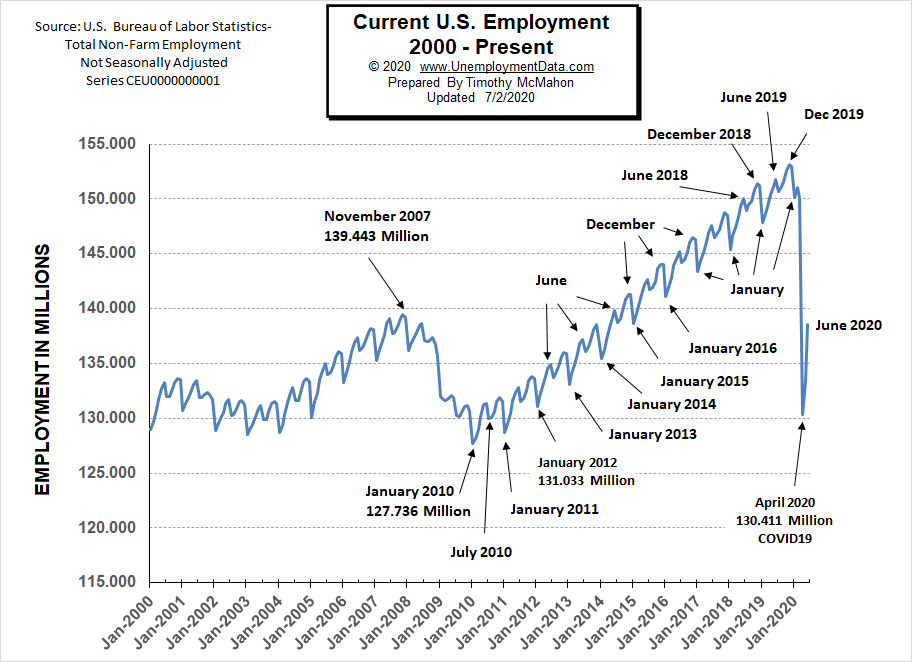
Employment by Sector
The employment “bubble chart” gives us a good representation of how each sector of the economy is doing (employment wise on a seasonally adjusted basis). Two months ago, we had the worst looking sector chart ever. Not a single sector had a gain (i.e. all sectors are to the left of the zero line). This month only 2 sectors remain below the zero line. They were Utilities, and Mining.
Leisure and Hospitality gained 2,088,000 jobs after gaining over a million last month but they had lost over -7 million jobs the month before. Retail gained 739,800 after losing roughly -2 million jobs in April. Manufacturing gained 357,000 jobs.
Transportation gained almost 100,000 employees. Construction gained 158,000 jobs, and Wholesale gained back 67,600 of their lost -362,800 employees.
Professional and business services gained 306,000, Education and Health gained 568,000 while other services gained 357,000.
Average weekly wages fell from $1,032.33 in May to $1,013.27 in June primarily due to the rehiring of lower-wage workers.
(See the table below for details.)
How to read this chart:
Bubbles location on the chart tell us two things:
- Change in Employment Levels over the most recent month.
- Average Weekly earnings.
- The further to the right the bubble the larger the increase in the number of jobs.
- The higher up on the chart the larger the average salary.
Bubble Size tells us:
- Total Employment for the sector.
- Larger bubbles mean more people are employed in that sector.
Employment and Average Weekly Earnings by Industry
June 2020, Seasonally Adjusted
| Industry | Monthly Increase | Average Weekly Earnings | Employment Level |
| Total Private Employment | 4,767,000 | $1,013.27 | 116,526,000 |
| Mining and Logging | -10,000 | $1,518.53 | 624,000 |
| Construction | 158,000 | $1,230.02 | 7,167,000 |
| Manufacturing | 356,000 | $1,119.94 | 12,095,000 |
| Wholesale trade | 67,600 | $1,234.24 | 5,616,900 |
| Retail trade | 739,800 | $648.02 | 14,398,900 |
| Transportation and Warehousing | 98,700 | $959.36 | 5,178,800 |
| Utilities | -3,200 | $1,833.71 | 537,500 |
| Information | 9,000 | $1,577.90 | 2,579,000 |
| Financial Activities | 32,000 | $1,436.37 | 8,608,000 |
| Professional and Business Services | 306,000 | $1,275.95 | 19,720,000 |
| Education and Health Services | 568,000 | $940.37 | 22,772,000 |
| Leisure and Hospitality | 2,088,000 | $433.25 | 12,040,000 |
| Other Services | 357,000 | $859.50 | 5,189,000 |
U1 through U6 Unemployment Rates
In April all the various measurements of Seasonally Adjusted Unemployment from U-1 through U-6 spiked up sharply except U1 which measures unemployment over 15 weeks. In May we saw a decline in all of them except U1 as expected. This month they all fell except U1 indicating that unemployment for some people has now lasted more than 15 weeks.
For more information about the various measurements of unemployment see What Is U-6 Unemployment?
Employed Part-Time for Economic Reasons
Throughout this shutdown, in addition to those who lost their jobs outright, many were forced to work part-time although they would rather work full-time. In May that number decreased slightly and it fell further in June. The other thing that is obvious in this chart is the blue shaded area which indicates that the BLS considers a recession to have started in February and has not ended yet.
Source: Bureau of Labor Statistics
Layoff Status
This chart may be one of the most troubling of all the charts this month. Initially, it looked good that the majority of the job losses were considered temporary lay-offs rather than permanent. But this month temporary lay-offs dropped as you would expect as people return to work but permanent job losses increased indicating that some job losses that were initially classified as temporary now appear to be permanent.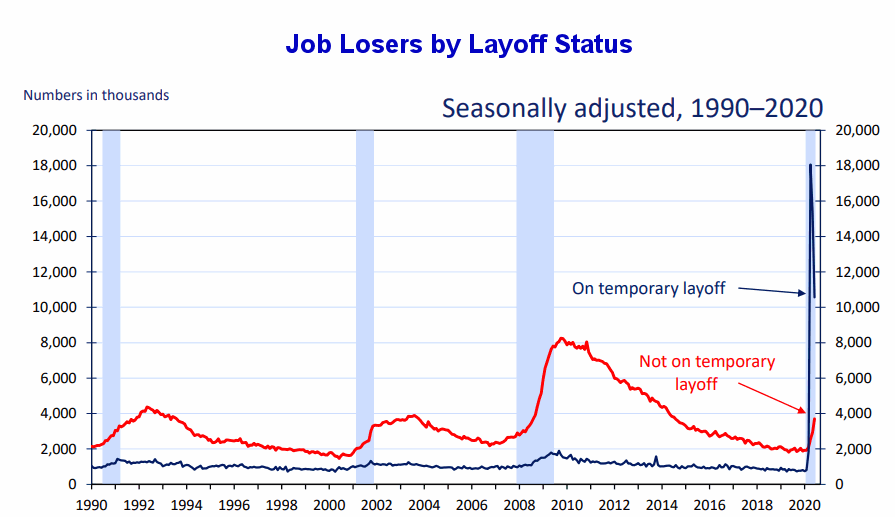
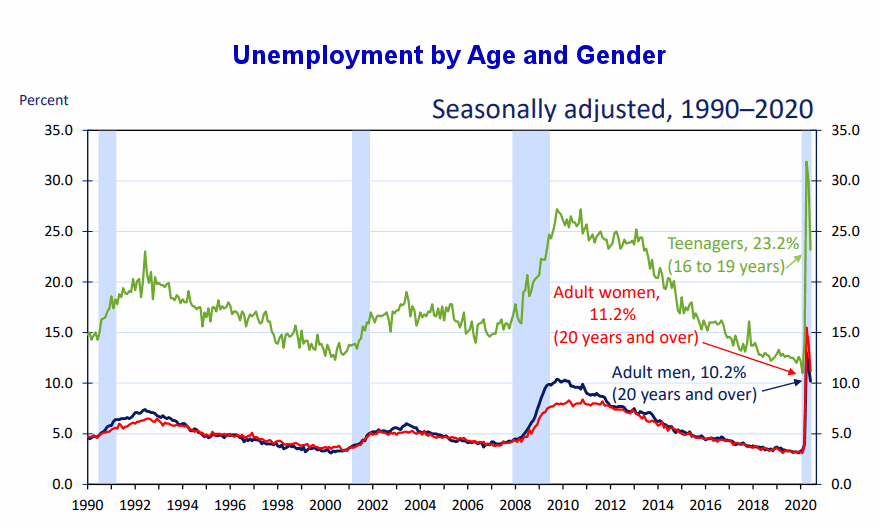
Previous Record Low Unemployment (Seasonally Adjusted U-3)
If we consider anything 4% or below as “low” we have had a few “low” stretches as we can see in the table below.
(4% or below in Green)
| Jan | Feb | Mar | Apr | May | Jun | Jul | Aug | Sep | Oct | Nov | Dec | |
| 1950 | 6.5% | 6.4% | 6.3% | 5.8% | 5.5% | 5.4% | 5.0% | 4.5% | 4.4% | 4.2% | 4.2% | 4.3% |
| 1951 | 3.7% | 3.4% | 3.4% | 3.1% | 3.0% | 3.2% | 3.1% | 3.1% | 3.3% | 3.5% | 3.5% | 3.1% |
| 1952 | 3.2% | 3.1% | 2.9% | 2.9% | 3.0% | 3.0% | 3.2% | 3.4% | 3.1% | 3.0% | 2.8% | 2.7% |
| 1953 | 2.9% | 2.6% | 2.6% | 2.7% | 2.5% | 2.5% | 2.6% | 2.7% | 2.9% | 3.1% | 3.5% | 4.5% |
| 1954 | 4.9% | 5.2% | 5.7% | 5.9% | 5.9% | 5.6% | 5.8% | 6.0% | 6.1% | 5.7% | 5.3% | 5.0% |
| 1955 | 4.9% | 4.7% | 4.6% | 4.7% | 4.3% | 4.2% | 4.0% | 4.2% | 4.1% | 4.3% | 4.2% | 4.2% |
| 1956 | 4.0% | 3.9% | 4.2% | 4.0% | 4.3% | 4.3% | 4.4% | 4.1% | 3.9% | 3.9% | 4.3% | 4.2% |
| 1957 | 4.2% | 3.9% | 3.7% | 3.9% | 4.1% | 4.3% | 4.2% | 4.1% | 4.4% | 4.5% | 5.1% | 5.2% |
| 1958 | 5.8% | 6.4% | 6.7% | 7.4% | 7.4% | 7.3% | 7.5% | 7.4% | 7.1% | 6.7% | 6.2% | 6.2% |
| … | … | … | … | … | … | … | … | … | … | … | … | … |
| 1965 | 4.9% | 5.1% | 4.7% | 4.8% | 4.6% | 4.6% | 4.4% | 4.4% | 4.3% | 4.2% | 4.1% | 4.0% |
| 1966 | 4.0% | 3.8% | 3.8% | 3.8% | 3.9% | 3.8% | 3.8% | 3.8% | 3.7% | 3.7% | 3.6% | 3.8% |
| 1967 | 3.9% | 3.8% | 3.8% | 3.8% | 3.8% | 3.9% | 3.8% | 3.8% | 3.8% | 4.0% | 3.9% | 3.8% |
| 1968 | 3.7% | 3.8% | 3.7% | 3.5% | 3.5% | 3.7% | 3.7% | 3.5% | 3.4% | 3.4% | 3.4% | 3.4% |
| 1969 | 3.4% | 3.4% | 3.4% | 3.4% | 3.4% | 3.5% | 3.5% | 3.5% | 3.7% | 3.7% | 3.5% | 3.5% |
| 1970 | 3.9% | 4.2% | 4.4% | 4.6% | 4.8% | 4.9% | 5.0% | 5.1% | 5.4% | 5.5% | 5.9% | 6.1% |
| … | … | … | … | … | … | … | … | … | … | … | … | … |
| 1999 | 4.3% | 4.4% | 4.2% | 4.3% | 4.2% | 4.3% | 4.3% | 4.2% | 4.2% | 4.1% | 4.1% | 4.0% |
| 2000 | 4.0% | 4.1% | 4.0% | 3.8% | 4.0% | 4.0% | 4.0% | 4.1% | 3.9% | 3.9% | 3.9% | 3.9% |
| 2001 | 4.2% | 4.2% | 4.3% | 4.4% | 4.3% | 4.5% | 4.6% | 4.9% | 5.0% | 5.3% | 5.5% | 5.7% |
| … | … | … | … | … | … | … | … | … | … | … | … | … |
| 2018 | 4.1% | 4.1% | 4.1% | 3.9% | 3.8% | 4.0% | 3.9% | 3.9% | 3.7% | 3.7% | 3.7% | 3.9% |
| 2019 | 4.0% | 3.8% | 3.8% | 3.6% | 3.6% | 3.7% | 3.7% | 3.7% | 3.5% | 3.6% | 3.5% | 3.5% |
| 2020 | 3.6% | 3.5% | 4.4% | 14.7% | 13.3% | 11.1% |
Employment
Historically employment is closely tied to recessions and that is no accident. One of the primary factors in calculating whether the economy is officially in a recession is an increase in the unemployment rate. The chart below provides the Historical Employment Data overlaid on blue bars showing periods of official recessions. We can see that the number of people employed has fallen below the 2007 peak, nearing the lows of the 2008-2010 crash and has now rebounded back to neat the 2007 peak level. As mentioned above we have officially been in a recession since February. What we can’t see very well on this chart is the rebound this month over the last couple of months.
See Historical Employment Data for more info.
Current Employment
Typically the low point for each year occurs in January and then it moves almost straight up to a small peak around June with a slight drop around July and then the highest peak in employment happens in November/December.
But the COVID virus has shortcircuited the normal trend and we saw a drop which began in March and by April it took employment back down to approximately the level of July 2010. June saw employment rebound to approximately the January 2015 level. But since this was June (the mid-year peak) it is possible that employment will fall off a bit in July if normal year patterns are followed.
See Current Employment for more info.
Labor Force Participation Rate
Even though Unemployment was in record low territory for quite some time, it wasn’t until January and February 2020, that the LFPR was finally able to claw its way back to 63.4%, its highest level since 2013.
Then COVID decimated all those gains dropping the LFPR down to 60.2% in April. In May it began to rebound and in June the LFPR was able to bounce back a little more to 61.5%.
See Labor Force Participation Rate for more information.
If you would like to receive this monthly report and other article updates click here you can unsubscribe at any time.
Here are some articles you might enjoy in case you missed them:
Read more on UnemploymentData.com.
- 3 Ways to Afford Medical Treatment When You’re Between Jobs
- Three Ways You Can Market Your Freelance Business
- 4 Tests And Examinations You Need to Pass Before Becoming a Trucker
- Tips for Starting a Business While Unemployed
From InflationData.com
- 5 Countries Most at Risk for Deflation
- May Inflation “Astonishingly Low”
- Why Inflation Affects Various Individuals Differently
From Financial Trend Forecaster
- Mutual Funds
- Bulls Beware: A Dark Cloud Is Forming Over Oil Markets
- Oil Goes from Zero to $35 in a Month, But is it Enough?
From Elliott Wave University
- Emerging Markets and Epidemics
- Deflationary Psychology Versus the Fed: Here’s the Likely Winner
- Crude Oil’s 2020 Crash: See What Helped (Some) Traders Pivot Just in Time
From OptioMoney.com
- Should You Buy a Second Home?
- Learning to Trade from Video Tutorials
- Five Business Tips to Help Your Company Thrive
From Your Family Finances

